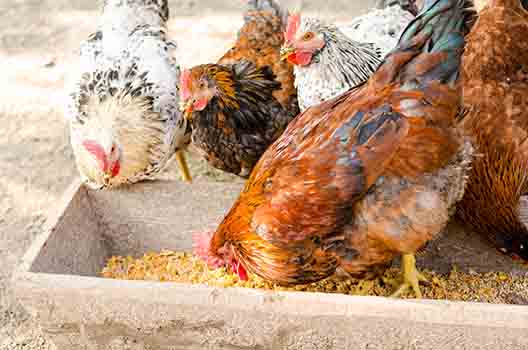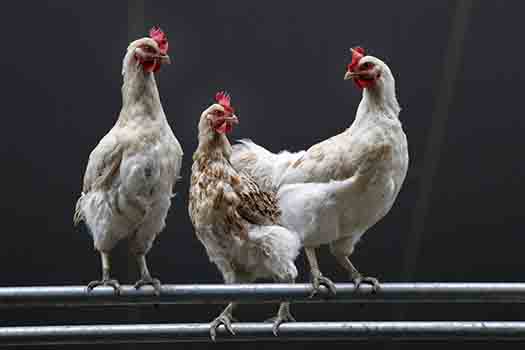Many factors contribute to the color of a chicken’s egg — the subspecies being the most impactful. At the beginning of egg production, all eggs are white, but both genetics and age alter the appearance of the egg. It takes a chicken about 26 hours to produce an egg; twenty of those just to form the shell. The other six hours determine what type of pigment will be released.
Here’s a fun fact: a chicken’s earlobe may be a key indicator as to what color the egg will lay. In this way, hens with white ear cartilage normally lay white eggs, while hens with red ear cartilage typically lay hued or darker, blue, green and pink eggs… indeed, I said pink eggs.
It is notable to mention that only female chickens (hens) can produce eggs. Hens come in a variety of breeds, boasting over 52 subspecies! As you can imagine, many of them share the same genetic makeup, allowing for multiple kinds to yield-related results.
The Average White Egg – Looks Aren’t Everything

The white egg may seem ordinary from afar but don’t be deceived by its looks. The majority of chickens can produce white eggs and by doing so, proves their resilience. This egg, unlike others, merely comes without pigment from the hen’s reproductive system. Even though these eggs may seem bland and boring, they pack the same nutrients to that of the brown egg, contrary to popular belief.
LegHorns
Perhaps the most active chicken, these birds are renowned for their egg production and vitality. It is said that you can quickly amass 280 in a year. Their eggs may also be the brightest of the bunch, coming from the traditional anglicization of Livorno, a Tuscan port from which the first birds were exported to North America.
Silkies
These chickens also produce beautiful white eggs. Their unique docile behavior ranks them above most of their subspecies. Their precious fur makes you never want to let go of them, and their obsessive need to always be cuddled only adds to that. If you’re planning on getting your child a pet, the silkie chicken may be worth considering – and who doesn’t love free eggs? The Showgirl Silkie lay eggs of various colors, from white to cream.
Polish
The Polish subspecies is, without a doubt, the most fashionable when it comes to style. Their unique pattern not only baffles spectators but prompts the question: Why isn’t their egg that color? If you flip their ear upwards, you’ll notice a pristine white patch covering their earlobe. As noted earlier, this can be a clue into which color egg they can produce. In correlation with the earlobe, the Polish breed also provides white eggs.
Other Breeds That Produce White Eggs:
- Hamburgs
- Sebrights
- Lakenvelders
- Minorcas
- Andalusians
The Beloved Brown Egg

It has long been stated that brown eggs pack more nutrition when compared against the white egg. This myth was debunked by Anim Genet, a biologist who studies fowls.
For a chicken to produce a brown egg, they must first possess the pigment known as protoporphyrin, which can be found in the hen’s hemoglobin. Once this puzzle piece fits, the egg can then be shaded a shade brown. The shade can differ due to the breed and genes, but overall the original tone is a nude brown. To make the process even more confusing, some hens occupy a gene that actually suppresses the brown pigment from being painted on.
To add some flavor to this data, did you know that the darker egg shading is lighter in the hotter months? Also, as hens grow old, their eggs will contain less shade and lean toward the lighter end of the dark-colored range. This is due to both the environment and their menstrual cycle, resulting in an influx of less/more protoporphyrin, the enzyme which paints it brown.
Rhode Island Reds
The Rhode Island Red is one of the most versatile chickens out there, being able to thrive in climates with extreme tropical conditions or harsh winter snowfalls. This is doable because of their different coat, which allows them to shed when it senses heat or bulk up when it’s freezing. On top of all these fantastic features, they’re able to produce large amounts of brown eggs year-round.
Plymouth Rocks
The Plymouth Rock is a chicken that is well-respected throughout America because of their relaxed, radiant, and responsive attitudes towards humans. Their egg-production is on their time – not yours. Although you may get fewer eggs in a year, you can expect nothing but quality when harvesting them. Plymouth Rocks are known for their rich brown eggs to taste better and sweeter, as well as larger.
Barnevelders
This breed of chicken is notorious when roaming the backyards of Australia. Amongst other kinds, they are a quick standout due to their unique plumage, quirky personality, and dark brown egg that eludes all others. Their vibrant feathers come equipped with an iridescent green tinge that shimmers in the sun, giving awe to nearby onlookers. Overall, the Barnevelders make one great suburban backyard hen.
Other Breeds That Produce Brown Eggs
- Dominiques
- Delawares
- Cochins
- Brahmas
- Chanteclers
- Wyandottes
Blue Eggs, Green Eggs, and Pink Eggs – They Do Exist

These eggs are not rare, but they’re not common either. As you would imagine, the color of the shell usually seeps down into the egg white, making for a picturesque meal. Similar to the brown egg, certain pigments are called porphyrins; furthermore, they impact the shading in about everything, the distance from flowers to human blood. Concentrated protoporphyrin results in brown eggs while biliverdin, a green tetrapyrrolic bile pigment, subjects the egg to a blue or green-hued egg.
A study published by the University of Nottingham School of Biology showed the influence of the blue-green eggs, surmising the mystery once and for all (1). Taking everything into account, analysts found that an old infection in local South American hens brought about a genetic change that set off an aggregation of biliverdin, making the chickens deliver blue/green eggs (1). This understanding gives researchers a motivation behind why as well as how the shade of the egg does not influence quality.
Breeds That Produce Blue/Green Eggs:
- Ameraucanas
- Araucanas
- Cream Legbars
- Olive Eggers
- Easter Eggers
Breeds That Produce Pink Eggs:
Pink eggs are a combination of pigments biliverdin and protoporphyrin. Pink eggs are the consequence of the sprout or cuticle being painted on only before the egg being laid, affecting its overall shell-tone. Just a few breeds can produce pink eggs making them even rarer than blue or green eggs.
The Rare Speckled Egg
Perhaps the most unique egg of all, only two breeds are known to produce this kind of anomaly on a regular basis: the Cuckoo Marans and the Welsummers. Other breeds do, at times, lay these specimens, but this is very rare and is unpredictable. This phenomenon happens when the egg is its final production, usually where calcium is introduced. Extra deposits of calcium are inserted on the shell, thus making pretty speckles. In addition to this, the egg rotates more slowly than that of your speckless egg.
National Geographic found that speckled eggs might be a way to make shells stronger, pointing us towards how chickens can sense depravity throughout their offspring.




